Cytokines are a group of small molecule proteins or polypeptides that are synthesized, stimulated, or secreted by immune cells (including monocytes, macrophages, T cells, B cells, NK cells, etc.) and other non-immune cells (endothelial cells, epidermal cells, fibers mother cells, etc.). Cytokines can communicate information between cells.
Other behaviors cytokines can perform include immune regulation and effector functions, including the control of adaptive immunity, innate immunity, cell growth, hematopoiesis, repair of damaged tissues, and differentiation. Cytokines play a key role in the immune system by helping manage the intensity and length of immune responses.
Many cytokines either assist or hinder each other in vivo, contributing to a highly complex immune regulatory network. Individual cytokines utilize their biological effects in autocrine, paracrine, or endocrine modes and have several different properties, such as pleiotropic, overlapping, antagonistic, and synergistic.
Specific circumstances can also lead to cytokines participating in the occurrence of various diseases and even provoke cytokine storm and cytokine storm syndrome—this can lead to organ damage, functional failure, and even death.
Complex and dynamic interactions between cytokines and their receptors mediate chronic inflammation and the immunosuppressive tumor microenvironment. This mediation can lead to tumor progression, metastasis, and reduced response to therapy. After tumors, autoimmune diseases are the second-largest therapeutic field.
Blocking cytokine function can help relieve tissue damage and inflammation in autoimmune diseases as they are considered the final effector proteins. With the progress being made in biopharmaceutical technology, there is a significant space for the future growth of targeted cytokine drugs. This offers a good prospect for effectively treating tumors and autoimmune diseases.
“Cytokine” is a generic name that can be subdivided into interleukins, growth factors, tumor necrosis factors, chemokines, colony-stimulating factors, interferons, etc. ACROBiosystems offers its clients a series of recombinant cytokines and their receptors with high purity, bioactivity, and batch-to-batch consistency to expedite existing scientific research and drug development programs.
Product features
- Expressed by HEK293 cells, offering a product closer to the natural conformation in humans
- Various species: Human, mouse, rat, cynomolgus, rhesus macaque, rabbit, canine, appropriate for cross-species experimentation
- Numerous labels and tags
- Biotinylated cytokines produced exclusively using the AvitagTM technology: biotinylation only happens on the lysine residue of Avi tag; no interference with the target protein’s natural binding activities; the protein orientation is consistent when immobilized on an avidin-coated surface
- High purity and homogeneity in structure validated by both SDS-PAGE and SEC-MALS
- High bioactivity of binding with receptor or antibody validated by ELISA/SPR/BLI/cell-based assay. Protocols shared
- Stringent quality control to ensure high batch-to-batch consistency (ELISA as QC test)
- A broad range of cytokine products; hot cytokine targets available
Hot cytokines
Source: ACROBiosystems
| . |
. |
. |
| IL-2 and IL-2 Receptors Patented Technology |
IL-4 and IL-4 R alpha |
IL-6 and IL-6 Receptors |
| IL-23A&IL-12B |
VEGF Family |
TGF-beta |
| FGF |
TNF-alpha |
GDF-15 |
| CSF |
EGF and EGF Receptors |
IGF-I R |
| CTGF |
Complement C3 |
Complement C5 |
Verification data
High purity and homogeneity in structure
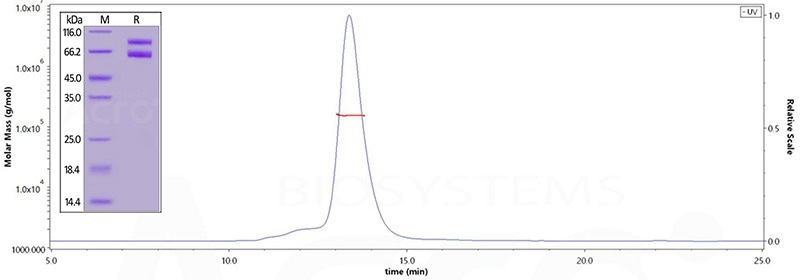
Human IL-2RB&IL-2RG Heterodimer Protein, Fc Tag&Fc Tag (MALS verified) (Cat. No. ILG-H5254) on SDS-PAGE under reducing (R) condition. The purity of the protein is greater than 95%. As verified by SEC-MALS, the purity is more than 90% and the molecular weight of this protein is around 140-160 kDa. Image Credit: ACROBiosystems
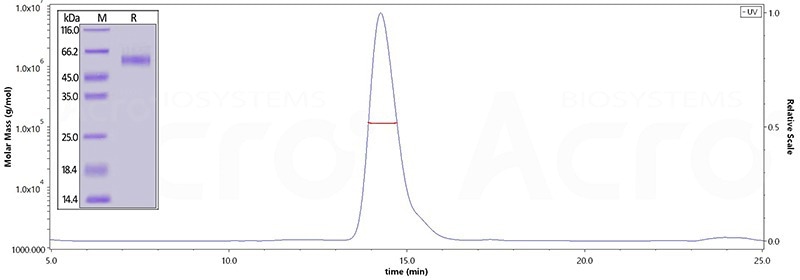
Biotinylated Human TGFBR2, Fc,Avitag (Cat. No. TG2-H82F6) on SDS-PAGE under reducing (R) condition. The purity of the protein is greater than 95%. As verified by SEC-MALS, the purity is more than 90% and the molecular weight of this protein is around 110-125 kDa. Image Credit: ACROBiosystems
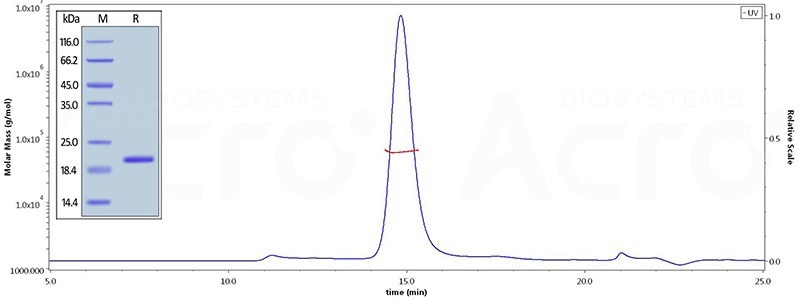
Biotinylated Human TNF-alpha, His,Avitag (active trimer) (MALS verified) (Cat. No. TNA-H82E3) on SDS-PAGE under reducing (R) condition. The purity of the protein is greater than 95%. As verified by SEC-MALS, the purity is more than 90% and the molecular weight of this protein is around 55-70 kDa. Image Credit: ACROBiosystems
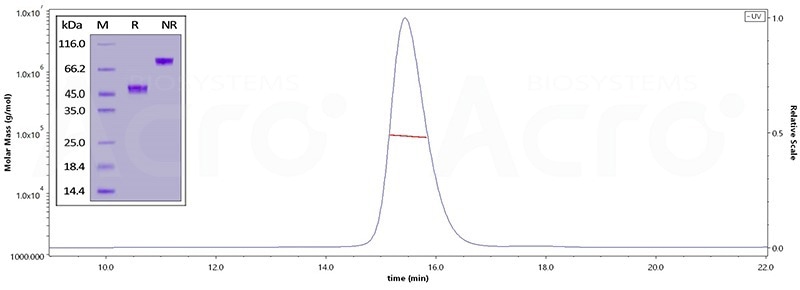
Human GDF-15, Fc Tag (Cat. No. GD5-H5269) on SDS-PAGE under reducing (R) and non-reducing (NR) conditions. The purity of the protein is greater than 95%. As verified by SEC-MALS, the purity is more than 90% and the molecular weight of this protein is around 74-100 kDa. Image Credit: ACROBiosystems
High bioactivity verified by ELISA (QC tested)
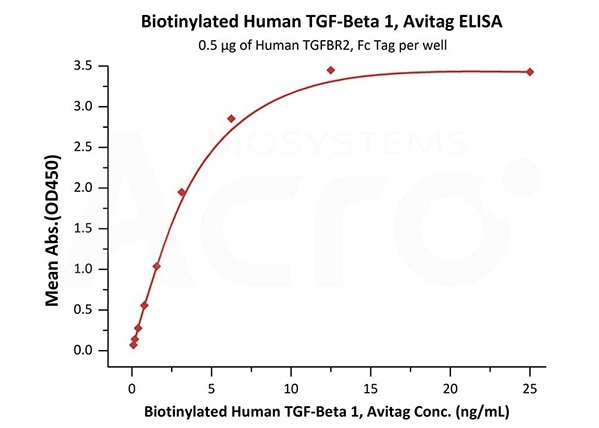
Immobilized Human TGFBR2, Fc Tag (Cat. No. TG2-H5252) at 5 μg/mL (100 μL/well) can bind Biotinylated Human TGF-Beta 1, Avitag (Cat. No. TG1-H8217) with a linear range of 0.1-3 ng/mL (QC tested). Image Credit: ACROBiosystems
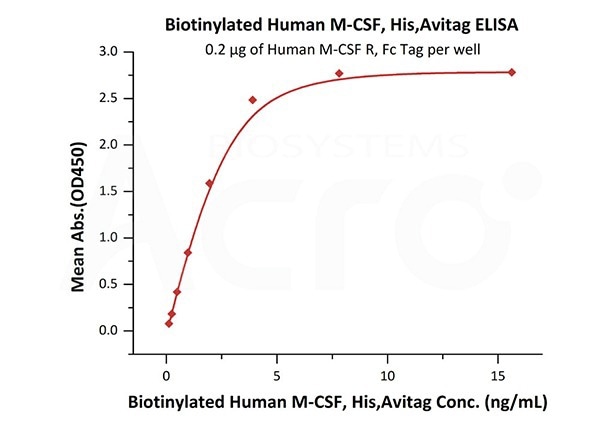
Immobilized Human M-CSF R, Fc Tag (Cat. No. CSR-H5258) at 2 μg/mL (100 μL/well) can bind Biotinylated Human M-CSF, His, Avitag (Cat. No. MCF-H82E6) with a linear range of 0.1-2 ng/mL (QC tested). Image Credit: ACROBiosystems
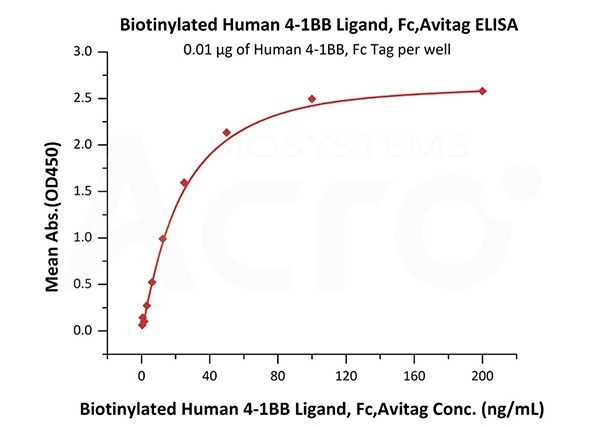
Immobilized Human 4-1BB, Fc Tag (Cat. No. 41B-H5258) at 0.1 μg/mL (100 μL/well) can bind Biotinylated Human 4-1BB Ligand, Fc, Avitag (Cat. No. 41L-H82F9) with a linear range of 0.4-6 ng/mL (QC tested). Image Credit: ACROBiosystems
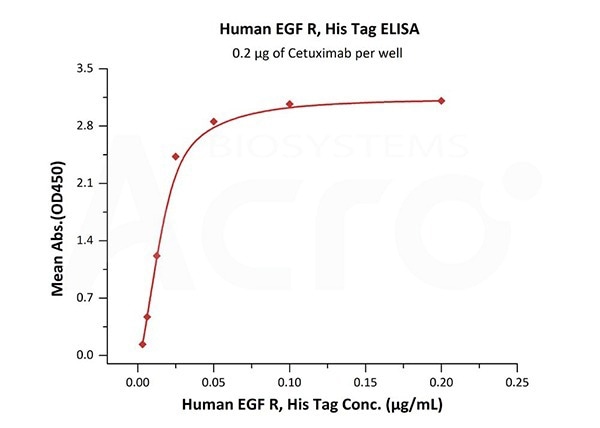
Immobilized Cetuximab at 2 μg/mL (100 μL/well) can bind Human EGF R, His Tag (Cat. No. EGR-H5222) with a linear range of 0.006-0.025 μg/mL (QC tested). Image Credit: ACROBiosystems
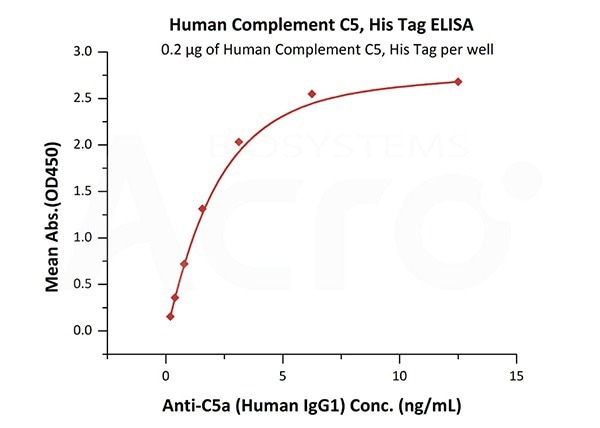
Immobilized Human Complement C5, His Tag (Cat. No. CO5-H52Ha) at 2 μg/mL (100 μL/well) can bind Anti-C5a (Human IgG1) with a linear range of 0.2-3 ng/mL (QC tested). Image Credit: ACROBiosystems
Affinity verified by SPR/BLI
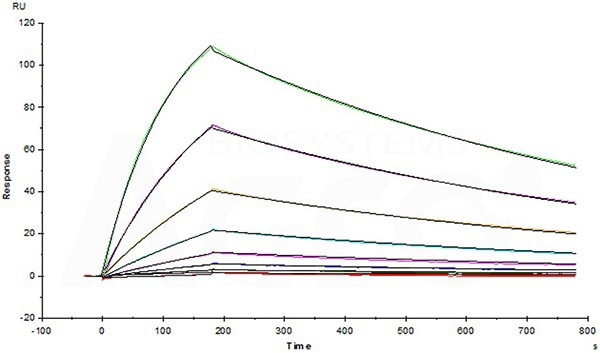
Erbitux (Cetuximab) captured on CM5 chip via anti-human IgG Fc antibodies surface, can bind Human EGF R, His Tag (Cat. No. EGR-H5222) with an affinity constant of 1.3 nM as determined in a SPR assay (Biacore T200). Image Credit: ACROBiosystems
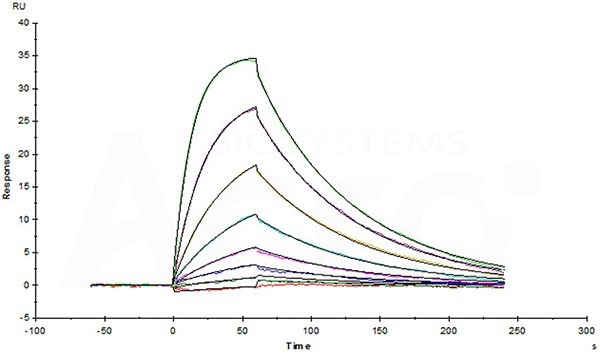
Human IL-2 R beta Protein, His Tag (Cat. No. CD2-H5221) captured on CM5 chip via anti-His antibody, can bind Human IL-15, premium grade (Cat. No. IL5-H4117) with an affinity constant of 21.7 nM as determined in a SPR assay (Biacore T200) (Routinely tested). Image Credit: ACROBiosystems
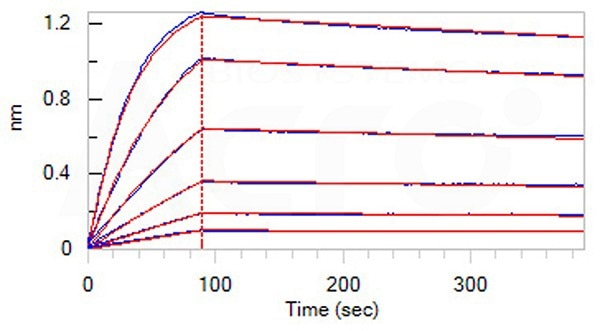
Loaded Anti-IL23A & IL12B MAb (P40 domain) on Protein A Biosensor, can bind Human IL-12B&IL-12A Heterodimer Protein, His Tag&Flag Tag (Cat. No. IL2-H4210) with an affinity constant of 1.07 nM as determined in BLI assay (ForteBio Octet Red96e). Image Credit: ACROBiosystems
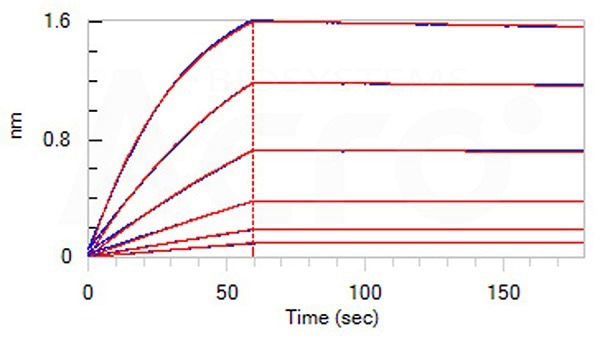
Loaded Anti-IL23A & IL12B MAb (P40 domain) on Protein A Biosensor, can bind Human IL-23A&IL-12B Heterodimer Protein, His Tag&Tag Free (Cat. No. ILB-H52W5) with an affinity constant of 0.588 nM as determined in BLI assay (ForteBio Octet Red96e). Image Credit: ACROBiosystems
High batch-to-batch consistency
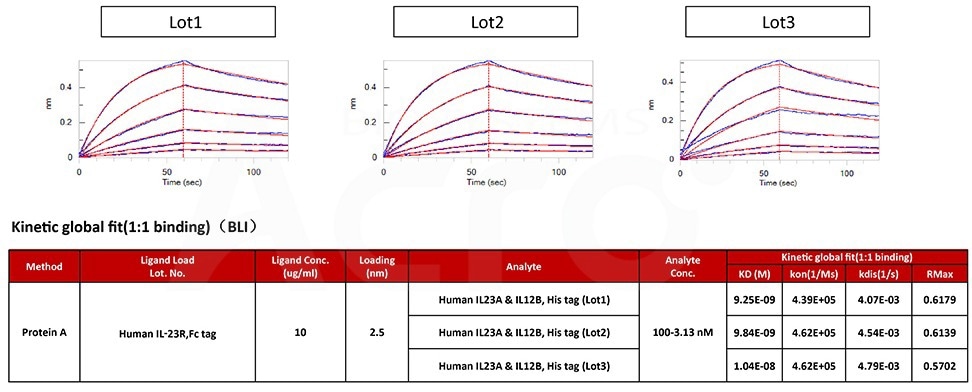
Affinity of three different lots of Human IL23A & IL12B, His Tag protein (Cat. No. ILB-H52W5) is verified by binding with Human IL-23R, and the result shows very high batch-to-batch consistency. (BLI). Image Credit: ACROBiosystems
Product list
Interleukins and receptors
Source: ACROBiosystems
| . |
. |
. |
. |
. |
| IL-1 alpha |
IL-1 beta |
IL-1 RAcP |
IL-1 RII |
IL-1 Rrp2 |
| IL-1RL1 |
IL-2 |
IL-2 R alpha |
IL-2 R beta |
IL-2 R gamma |
| IL-2 R beta & IL-2 R gamma |
IL-2 R beta & IL-2
R alpha & IL-2 R gamma |
IL-3 |
IL-3 R alpha |
IL-4 |
| IL-4 R alpha |
IL-5 |
IL-5 R alpha |
IL-6 |
IL-6 R alpha |
| gp130 |
IL-7 |
IL-7 R alpha |
IL-7-P2A |
IL-8 |
| IL-10 |
IL-10 R alpha |
IL-11 |
IL-11 R alpha |
IL-12 R beta 1 |
| IL-12A |
IL-12B |
IL-12B & IL-12A |
IL-13 |
IL-13 R alpha 1 |
| IL-13 R alpha 2 |
IL-15 |
IL-15 R alpha |
IL-17A |
IL-17B |
| IL-17C |
IL-17E |
IL-17F |
IL-17A & IL-17F |
IL-17 RA |
| IL-17 RC |
IL-17 RA & IL-17 RC |
IL-17 RE |
IL-18 |
IL-18 R beta |
| IL-18 R1 |
IL-18BP |
IL-20 |
IL-20 R alpha |
IL-21 |
| IL-21 R |
IL-22 |
IL23A & IL12B |
IL-23R |
IL-26 |
| IL-27 |
IL-27 Ra |
IL-29 |
IL-31 |
IL-31 RA |
| IL-33 |
IL-34 |
IL-37 |
IL-38 |
|
Growth factors and receptors
VEGFs. Source: ACROBiosystems
| . |
. |
. |
. |
. |
| VEGF110 |
VEGF120 |
VEGF121 |
VEGF164 |
VEGF165 |
| VEGF189 |
VEGF-B |
VEGF-C |
VEGF-D |
VEGF R1 |
| VEGF R2 |
VEGF R3 |
|
|
|
TGFs. Source: ACROBiosystems
| . |
. |
. |
. |
. |
| TGF-beta 1 |
Latent TGF-beta 1 |
LAP (TGF-beta 1) |
LRRC32 & TGF-beta 1 |
TGF-beta 2 |
| Latent TGF-beta 2 |
TGF-beta 3 |
TGF-beta RII |
BMP-2 |
Gremlin |
FGFs. Source: ACROBiosystems
| . |
. |
. |
. |
. |
| FGF acidic |
FGF basic |
FGF-3 |
FGF-4 |
FGF-5 |
| FGF-6 |
FGF-7 |
FGF-8 |
EFGF-9 |
FGF-10 |
| FGF-19 |
FGF-21 |
FGF-23 |
FGF R1 |
FGF R2 (IIIb) |
| FGF R2 (IIIc) |
FGF R3 (IIIb) |
FGF R3 (IIIc) |
FGF R4 |
|
EGFs. Source: ACROBiosystems
| . |
. |
. |
. |
| EGF |
HBEGF |
EGFR |
EGFRVIII |
IGFs. Source: ACROBiosystems
| . |
. |
. |
. |
. |
| IGF-I |
IGF-II |
IGF-I R |
IGFBP-3 |
IGFBP-3 R |
| IGFBP-4 |
IGFBP-7 |
|
|
|
GDFs. Source: ACROBiosystems
| . |
. |
. |
. |
. |
| GDF-15 |
GFR alpha-like |
Latent GDF-2 |
GDF-2 |
Latent GDF-8 |
Other growth factors. Source: ACROBiosystems
| . |
. |
. |
. |
. |
| CTGF |
HGF |
HGF R |
PDGF-BB |
PDGF R alpha |
| PDGF R beta |
|
|
|
|
TNFs and receptors
Source: ACROBiosystems
| . |
. |
. |
. |
. |
| TNF-alpha |
TNFR1 |
TNFR2 |
TNFSF11 |
CD40 Ligand |
| CD27 ligand |
OX40 Ligand |
CD30 Ligand |
4-1BB Ligand |
TRAIL |
| TRAIL R1 |
TRAIL R2 |
TRAIL R4 |
TWEAK R |
APRIL |
| BAFF |
BAFF R |
LIGHT |
HVEM |
GITR |
| GITR Ligand |
|
|
|
|
Chemokines and receptors
Source: ACROBiosystems
| . |
. |
. |
. |
. |
| CCL1 |
CCL2 |
CCL3 |
CCL5 |
CCL7 |
| CCL14 |
CCL17 |
CCL19 |
CCL20 |
CCL22 |
| CX3CL1 |
CXCL4 |
CXCL10 |
CXCL12/SDF-1 |
CXCL13 |
| CXCL16 |
CCR5 |
CXCR4 |
|
|
CSFs and receptors
Source: ACROBiosystems
| . |
. |
. |
. |
. |
| M-CSF |
M-CSF R |
GM-CSF |
GM-CSF R alpha |
G-CSF |
| G-CSF R |
|
|
|
|
IFNs and receptors
Source: ACROBiosystems
| . |
. |
. |
. |
. |
| IFN-alpha 1 |
IFN-alpha 2b |
IFN-alpha/beta R1 |
IFN-alpha/beta R2 |
IFN-gamma |
| IFN-gamma R1 |
|
|
|
|
Complement components
Source: ACROBiosystems
| . |
. |
. |
. |
. |
Complement
C2 |
Complement
C3 |
Complement
C5 |
Complement
C5a |
Complement
Factor D |
Other cytokines
Source: ACROBiosystems
| . |
. |
. |
. |
. |
| Erythropoietin |
Betacellulin |
SCF |
CD117 |
MIS RII |
| LIF |
LIF R |
Oncostatin M |
Activin A |
Activin RIIA |
| NRG1 Beta 1 |
NRG4 |
CNTF R alpha |
|
|
About ACROBiosystems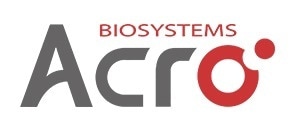
ACROBiosystems is a cornerstone enterprise of the pharmaceutical and biotechnology industries. Their mission is to help overcome challenges with innovative tools and solutions from discovery to the clinic. They supply life science tools designed to be used in discovery research and scalable to the clinical phase and beyond. By consistently adapting to new regulatory challenges and guidelines, ACROBiosystems delivers solutions, whether it comes through recombinant proteins, antibodies, assay kits, GMP-grade reagents, or custom services. ACROBiosystems empower scientists and engineers dedicated towards innovation to simplify and accelerate the development of new, better, and more affordable medicine.
Sponsored Content Policy: News-Medical.net publishes articles and related content that may be derived from sources where we have existing commercial relationships, provided such content adds value to the core editorial ethos of News-Medical.Net which is to educate and inform site visitors interested in medical research, science, medical devices and treatments.